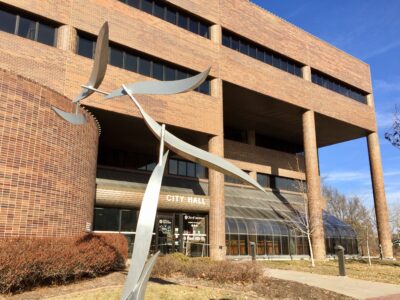Lawrence city commissioners set maximum property tax rate after lengthy debate, failed vote

photo by: Rochelle Valverde/Journal-World
Lawrence City Hall, 6 E. Sixth St., is pictured on Jan. 31, 2023.
City commissioners on Tuesday approved a maximum mill levy increase in line with the city manager’s 2025 budget proposal — after a failed vote and some concerns about a plan that could leave the door open for an even higher tax hike.
The commission ultimately voted 3-2, with Vice Mayor Mike Dever and Commissioner Lisa Larsen opposed, to set the maximum at 36.807 mills, up from the 2024 rate of 33.207 mills. But that wasn’t the proposal they were originally asked to vote on. That one would have been for a maximum that was two mills higher, at 38.907.
As the Journal-World has reported, City Manager Craig Owens assembled a 2025 budget proposal that would increase the city’s property tax rate by 3.5 mills, which would be the largest property tax hike in at least 50 years.
However, after firefighters and members of the public protested a plan to cut staffing on July 9, the commission asked city staff to create new scenarios that would keep the staffing at its current level.
That’s where the 38.907-mill figure comes from. Staffers said Tuesday that to keep fire staffing the same and build two new fire stations, the city would either have to raise the mill levy to that level, or cut $2.2 million from other departments.
The city was required to set its maximum mill levy by July 20, and once it’s set, the mill levy can be lowered but can no longer be raised. And the debate among commissioners was about whether the higher amount would give them more flexibility, or would be a step toward raising taxes even more than Owens had originally proposed.
Larsen and Dever were both in the latter camp. Dever warned commissioners that “when you set a number … decreasing it is very hard,” and Larsen said that if the maximum were higher, “I wouldn’t trust the commission to not use that whole amount.”
Commissioner Amber Sellers, meanwhile, said that the higher maximum was about giving the commission “the full deck of cards.” She said commissioners would then have time to work out the exact mill rate without being limited by a decision they made early in the process.
The commission eventually decided to vote on a lower maximum of 36.807 mills, and even that took two rounds of voting to pass. Initially, it failed on a 2-3 voice vote, but after discussion, the commission passed it on a subsequent vote 3-2.
Throughout the discussion, Dever emphasized that he was not in favor of raising the mill rate “at all.” He said that even though the city had fallen short of its sales tax collection targets, “we still have a robust economy,” and that the commission needed to work with Owens to find other ways to fund operations instead of asking for “more dollars from the community.”
“If not now, when are we going to stop asking for more money?” Dever said. “If we can’t manage the budget we have now with the money we have, I’m not quite sure what’s going to happen when the economy changes.”
In other business:
The City Commission unanimously approved a 20-year plan to replace or repair pedestrian paths like sidewalks and curb ramps to ensure they are compliant with the Americans with Disabilities Act.
Evan Korynta, the ADA compliance administrator for the city, said creating a plan is required both at the state and federal levels.
Korynta said while evaluating the 400 miles of sidewalk and 6,500 curb ramps under the city’s domain, his team found 280 miles of sidewalk needed improvement, with 92 miles of sidewalk needing to be fully replaced. He said 4,500 of the curb ramps needed to be repaired or replaced.
The city already set aside in its Capital Improvement Plan (CIP) about $1,928,000 per year for repairing or replacing sidewalks. The passage of this plan approves allocating an additional $2,588,000 per year to the CIP. That funding alongside $657,750 in property owner cost partnering would tally up to a total of $5,173,750 per year.
Those costs are estimated based on data from the city’s Sidewalk Improvement Program, Korynta said. Over the estimated 20-year length of the plan the cost would be a total of $103.5 million.
Angela Buzard, the general manager-admin with Municipal Services & Operations, acknowledged that the price tag was “not a light ask,” but she said funding this program would make the pedestrian infrastructure improvements less of a “piecemeal” approach and put it all under one program.
Korynta said although the plan had an ADA emphasis on it, the sidewalk improvements wouldn’t just be helpful to people with disabilities, but for all community members.
“(This helps) our young children walking to school or learning to ride a bike, our parents pushing strollers, our aging population,” Korynta said. “This really is a plan that is designed with equity and inclusion in mind.
• The Commission voted to finalize two grants with the Kansas Department of Transportation to rehabilitate Taxiway C of the Lawrence Regional Airport.
The city received a design grant of $38,000 and a construction grant of $337,500 from KDOT. As part of the grant agreements, the city matched a total of $40,000. The rehabilitation of the airport is a “top priority” to complete before the World Cup in 2026, with Lawrence in the running to possibly be a host city for a team’s base camp for games in Kansas City.







